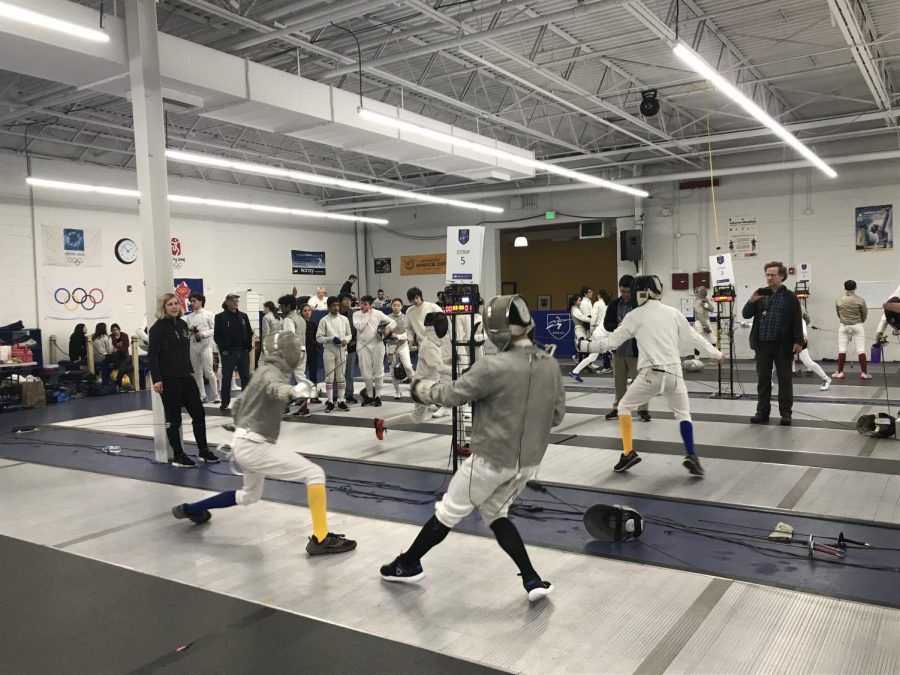Fencing: The Art of the Blade
CRLS Team Grows as Interest in Sport Peaks
February 4, 2020
The sport of fencing has many misconceptions associated with it. Sword fighting is in mainstream culture—it’s in movies, TV shows, and plays—however, the Olympic sport of fencing—an entirely different activity than sword fighting—lacks the same kind of representation as its Hollywood counterpart.
In the King Open School’s gym, Coach Stapleton and Coach Bell set up the space and get it ready for another fencing practice each week. During those late afternoons and evenings spent practicing, a community is formed through a common interest: stabbing each other.
Despite having roots based in swordsmanship, fencing is a sport that has grown and changed significantly throughout history. Nevertheless, important values such as courtesy, sportsmanship, and saluting opponents have survived over the years. When asked about what unique attribute was gained through fencing and how it changed him as a person, Bay State Fencers director and prominent figure in New England fencing, Stacy Eddy, said, “Patience and determination amongst others were two of the values that started tying into [his] life because of fencing.”
During a bout two fencers have a common main goal of striking their opponent with a blunt weapon while avoiding being hit themselves. The rules vary between the three weapons: the foil, the saber, and the epée. The different rules create unique strategies for each weapon and little crossover of style between the three disciplines. Despite the difference between different blades, the CRLS fencing squads, or groups of three to six people by blade and gender, find a way to unify each member and mix the individualistic sport with important team values and dynamics. As CRLS foil fencer Raj Kirpalani ’22 puts it, “The team aspect adds another layer of fun to the sport, and being a part of one makes the sport focus less on your own performance and more on that of your team.” Fencing on the CRLS team was a valuable experience for CRLS alumni and UMass fencer Aaron Pen ’19, whose love for fencing is derived from coaching teammates and “going out of [his] way to learn how to best coach people… Being able to talk to somebody through their actions during practices and especially in the middle of a bout is something [unique to] fencing.”
As the sport’s popularity increases, misconceptions about fencing are slowly fading, yet many still resist. Liliana Abramson ’20, epee team captain, argues against the common misconception that fencing is a “pretentious high-class sport,” claiming that fencing “can be expensive, but that’s why I love the CRLS team so much: we’re giving everyone an equal chance to learn and participate in such a fun and unique sport.” This year, the competitive team is comprised of 31 members, all of whom are striving to outdo previous teams’ performances of 5th place for the men’s team and 6th for the women in the State Championships.
Fencing is quite a challenging sport. The movement in a fencing bout (or match) is not natural and takes a lot of practice and determination to understand and perform correctly and at high speed. Because of these characteristics, fencing has often been referred to as “physical chess,” which is mainly due to the meticulous strategy put into each move or plan of attack either mentally or physically.
Despite the challenges fencers face, as CRLS Assistant Coach Bell likes to say, “It is an art, and like all arts, it is something you continually do and improve for yourself, becoming a long-term motivator.” Coming off of a great performance from all squads from the team’s first multi-meet of the season, CRLS Falcons are looking to improve their record and rank more than ever before in States. No matter the team’s performance in this competition or any other, though, one thing most CRLS fencers can agree on is that fencing at CRLS is much more than just a sport: it’s a community of people brought together by their passion and love for the sport, their competitiveness, and drive to improve.
This piece also appears in our January 2020 print edition










